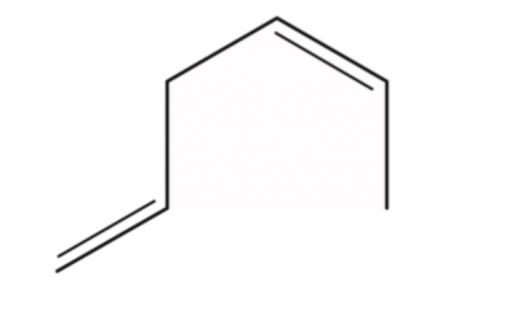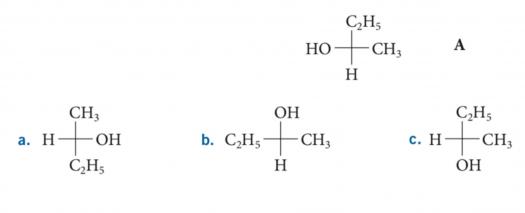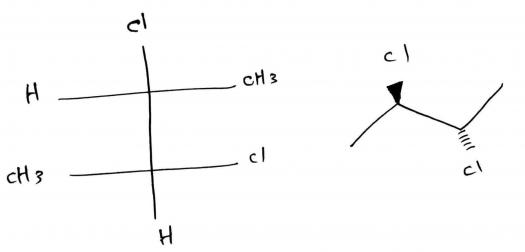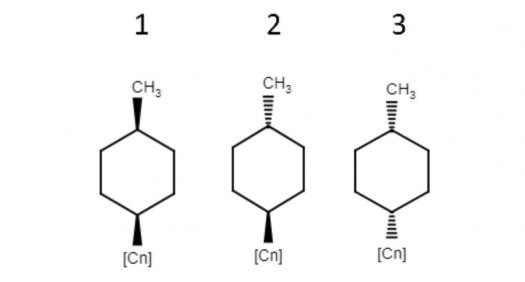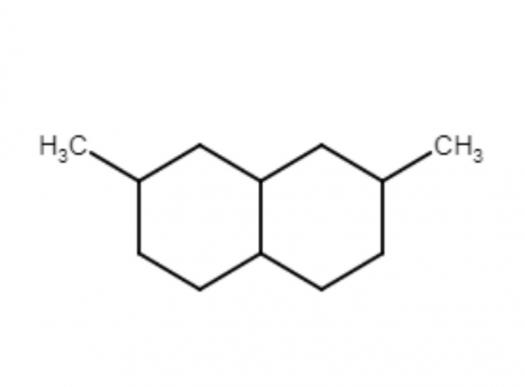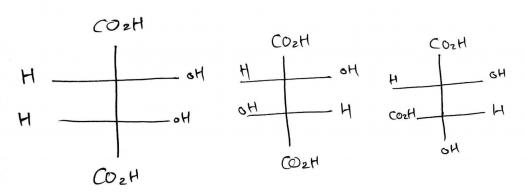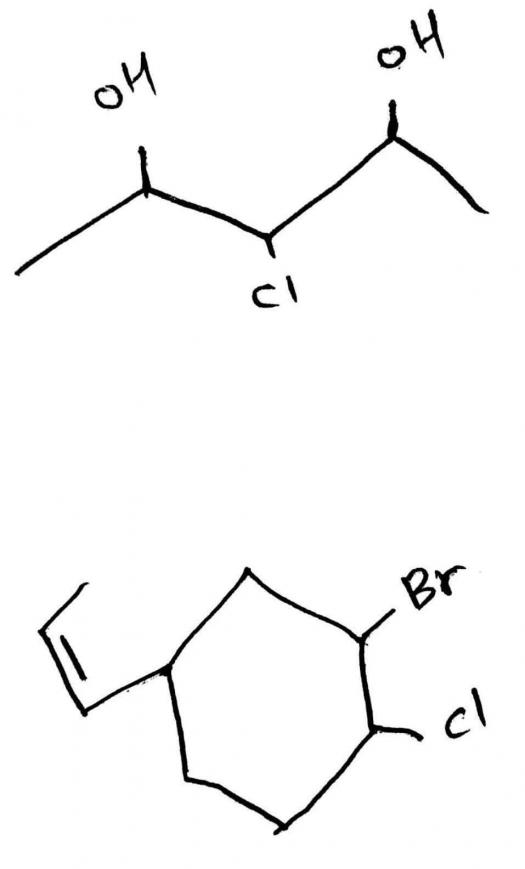Organic Chemistry Trivia Quiz

2nd exam
- 1.
Determine the configuration(R or S)as the stereogenic center in
- A.
(R,S)
- B.
(S,R)
- C.
(R,R)
- D.
(S,S)
Correct Answer
A. (R,S)Explanation
The configuration (R,S) indicates that the stereogenic center has two different groups attached to it, with one group positioned clockwise and the other group positioned counterclockwise. In this case, the first configuration (R,S) implies that the first group is positioned clockwise and the second group is positioned counterclockwise.Rate this question:
-
- 2.
Name the following compound
- A.
(E,E)-2-3-hexadiene
- B.
(S,S)-2,4-hexadiene
- C.
(E,S)-2-3-hexadiene
- D.
(Z)-1,4-hexadiene
Correct Answer
D. (Z)-1,4-hexadieneExplanation
The correct answer is (Z)-1,4-hexadiene. The (Z) prefix indicates that the two substituents on the double bond are on the same side of the molecule. In this case, the two substituents are the two hydrogen atoms on one end of the double bond and the two methyl groups on the other end. Since these substituents are on the same side, the compound is designated as (Z)-1,4-hexadiene.Rate this question:
-
- 3.
Which of the following Fischer projection formulas are enantiomer with A?
- A.
A only
- B.
B ,C
- C.
C only
- D.
A,B,C
Correct Answer
D. A,B,CExplanation
The given answer states that all of the Fischer projection formulas A, B, and C are enantiomers with A. This means that they have the same chemical formula and connectivity, but differ in their spatial arrangement. Enantiomers are mirror images of each other and have opposite stereochemistry. Therefore, A, B, and C must have the same molecular formula and connectivity, but differ in the arrangement of their substituents around the chiral carbon.Rate this question:
-
- 4.
Which of the following reactions under go SN2 reaction
- A.
A
- B.
B
- C.
C
- D.
D
Correct Answer
C. CExplanation
The SN2 reaction is a type of nucleophilic substitution reaction in which a nucleophile attacks an electrophilic center, resulting in the displacement of a leaving group. In order for a reaction to undergo SN2, it must have a strong nucleophile, a good leaving group, and a primary or methyl carbon center. Option C is the correct answer because it shows a primary carbon center, which is more likely to undergo SN2 reaction compared to the other options.Rate this question:
-
- 5.
What is the configuration at each stereogenic center
- A.
(S,S)
- B.
(R,S)
- C.
(R,R)
- D.
(S,R)
Correct Answer
C. (R,R)Explanation
The given answer (R,R) indicates that both stereogenic centers have the same configuration, which is "R". This means that both centers have the same arrangement of substituents around them in a clockwise direction.Rate this question:
-
- 6.
What is the relationship between the two following compounds
- A.
Enantiomers
- B.
Diastereomers
- C.
Different compound
- D.
Same compound
Correct Answer
D. Same compoundExplanation
The relationship between the two compounds is that they are the same compound. Enantiomers and diastereomers are different types of stereoisomers, meaning they have the same molecular formula but differ in their spatial arrangement. However, in this case, the answer states that the compounds are the same, implying that they are not stereoisomers but rather identical molecules.Rate this question:
-
- 7.
What is the relationship between the two following compounds
- A.
Enantiomers
- B.
Diastereomers
- C.
Different compound
- D.
Same compound
Correct Answer
A. EnantiomersExplanation
Enantiomers are a type of stereoisomers that are non-superimposable mirror images of each other. They have the same connectivity of atoms but differ in their spatial arrangement. Diastereomers, on the other hand, are stereoisomers that are not mirror images of each other and have different connectivity of atoms. Therefore, the relationship between enantiomers and diastereomers is that they are different compounds.Rate this question:
-
- 8.
The product from reaction trans-4-methylcyclohexyl bromide with cyanide ion.
- A.
1 only
- B.
2 only
- C.
2 and 3
- D.
1 and 2
Correct Answer
A. 1 onlyExplanation
The correct answer is 1 only. This means that the product is only formed from the reaction of trans-4-methylcyclohexyl bromide with cyanide ion. No other reactions or combinations are involved in the formation of the product.Rate this question:
-
- 9.
Arrange the following compounds in order of decreasing SN2 reactivity toward sodium ethoxide:
- A.
CH3CH2CH2CH2Br > CH3CH2CH(CH3)Br > (CH3)2CHCH2Br
- B.
(CH3)2CHCH2Br > CH3CH2CH2CH2Br > CH3CH2CH(CH3)Br
- C.
CH3CH2CH(CH3)Br > (CH3)2CHCH2Br > CH3CH2CH2CH2Br
- D.
CH3CH2CH2CH2Br > (CH3)2CHCH2Br > CH3CH2CH(CH3)Br
Correct Answer
D. CH3CH2CH2CH2Br > (CH3)2CHCH2Br > CH3CH2CH(CH3)BrExplanation
In SN2 reactions, the reactivity of alkyl halides is determined by the steric hindrance around the carbon atom attached to the halogen. The order of decreasing reactivity is based on the number of alkyl groups attached to the carbon atom. The more alkyl groups attached, the greater the steric hindrance, and therefore, the lower the reactivity. In this case, CH3CH2CH2CH2Br has no alkyl groups attached to the carbon atom, making it the most reactive. (CH3)2CHCH2Br has one alkyl group attached, making it less reactive than CH3CH2CH2CH2Br. CH3CH2CH(CH3)Br has two alkyl groups attached, making it the least reactive among the three compounds.Rate this question:
-
- 10.
Which reactions go under SN2 mechanism :-
- A.
1 only
- B.
1 and 2
- C.
3 only
- D.
2 and 3
Correct Answer
A. 1 onlyExplanation
The SN2 mechanism is a type of nucleophilic substitution reaction where the nucleophile attacks the substrate molecule and replaces a leaving group in a single step. In option 1, only one reaction is mentioned, indicating that it undergoes SN2 mechanism. The other options mention multiple reactions, so they do not exclusively go under SN2 mechanism.Rate this question:
-
- 11.
Which of the following compound is chiral :-
- A.
1-bromo-1-phenyl ethane
- B.
1-bromo-2-phenyl ethane
- C.
2-butene
- D.
Methyl cyclohexane
Correct Answer
A. 1-bromo-1-phenyl ethaneExplanation
1-bromo-1-phenyl ethane is chiral because it contains a chiral center. A chiral center is an atom that is bonded to four different groups. In this compound, the carbon atom bonded to the bromine, the phenyl group, a hydrogen atom, and an ethyl group is the chiral center. The other compounds listed do not have chiral centers and are therefore not chiral.Rate this question:
-
- 12.
How many sterogenic center are present in the following :-
- A.
1
- B.
2
- C.
3
- D.
4
Correct Answer
D. 4Explanation
There are four stereogenic centers present in the given structure. Stereogenic centers are carbon atoms that are bonded to four different groups, resulting in the ability to exist as two non-superimposable mirror images. In the given structure, there are four carbon atoms that meet this criterion, making them stereogenic centers.Rate this question:
-
- 13.
The product of the following reaction is :
- A.
A
- B.
B
- C.
C
- D.
A & B
Correct Answer
B. BExplanation
The product of the given reaction is B.Rate this question:
-
- 14.
What is the possible products for this rxn?
- A.
A
- B.
B
- C.
C
Correct Answer
B. BExplanation
The possible products for this reaction are B.Rate this question:
-
- 15.
When 2-methyl-1-butene is reacted with H-Br two stereoisomers are formed what is the relationship of these isomers
- A.
Identical
- B.
Meso
- C.
Diasteromers
- D.
Enantiomers
Correct Answer
A. IdenticalExplanation
When 2-methyl-1-butene reacts with H-Br, two stereoisomers are formed. If the two isomers are identical, it means that they are exactly the same in terms of their chemical structure and spatial arrangement. This implies that they have the same physical and chemical properties. Therefore, the relationship between the two isomers is "Identical".Rate this question:
-
- 16.
Which statement describes the mechanism of SN2 reaction :-
- A.
Does have an intermediate but no transition state
- B.
Does not have an intermediate but does have transition state
- C.
The rate of the reaction is first order
- D.
Does have an intermediate and transition state
Correct Answer
B. Does not have an intermediate but does have transition stateExplanation
The SN2 reaction mechanism does not involve the formation of an intermediate species, but it does have a transition state. In this mechanism, the nucleophile directly attacks the substrate, causing the leaving group to depart simultaneously. The transition state represents the highest energy point in the reaction pathway, where the bond between the nucleophile and the substrate is partially formed and the bond between the substrate and the leaving group is partially broken. The absence of an intermediate distinguishes the SN2 mechanism from the SN1 mechanism, where an intermediate carbocation is formed.Rate this question:
-
- 17.
What is the correct systemic name of the following compound :-
- A.
(R)-7-Bromo-(S)-2-Chlorooctane
- B.
(S)-2-Bromo-(R)-7-Chlorooctane
- C.
(R)-7-Bromo-(R)-2-Chlorooctane
- D.
(S)-2-Bromo-(S)-7-Chlorooctane
Correct Answer
B. (S)-2-Bromo-(R)-7-ChlorooctaneExplanation
The correct systematic name for the given compound is (S)-2-Bromo-(R)-7-Chlorooctane. This is determined by assigning the R or S configuration to each chiral center in the molecule based on the priority of the substituents attached to it. In this case, the bromine atom has higher priority than the chlorine atom at the second chiral center, and the chlorine atom has higher priority than the bromine atom at the seventh chiral center. Therefore, the compound is named (S)-2-Bromo-(R)-7-Chlorooctane.Rate this question:
-
- 18.
Rank the following five compounds in order of increasing acid strength: 2-chloroethanol, p-chlorophenol, p-methylphenol, ethanol, and phenol.
- A.
P-chlorophenol > p-methylphenol > phenol 2-chloroethanol > ethanol
- B.
P-chlorophenol > phenol > 2-chloroethanol > p-methylphenol > ethanol
- C.
P-chlorophenol > phenol > p-methylphenol > 2-chloroethanol > ethanol
- D.
Phenol > p-methylphenol > p-chlorophenol > ethanol > 2-chloroethanol
Correct Answer
C. P-chlorophenol > phenol > p-methylphenol > 2-chloroethanol > ethanolExplanation
The acidity of a compound is determined by the stability of its conjugate base. In this case, the compounds are compared based on their ability to donate a proton (H+) to form a stable conjugate base. The presence of electron-withdrawing groups, such as the chlorine atom in p-chlorophenol, increases the acidity by stabilizing the negative charge on the conjugate base. Therefore, p-chlorophenol is the most acidic compound. Phenol is less acidic than p-chlorophenol but more acidic than p-methylphenol because the phenoxide ion is stabilized by resonance. 2-chloroethanol and ethanol are weaker acids compared to the phenols because the oxygen atom in the hydroxyl group is less electronegative than the chlorine atom, resulting in a less stable conjugate base. Therefore, the correct order of increasing acid strength is p-chlorophenol > phenol > p-methylphenol > 2-chloroethanol > ethanol.Rate this question:
-
- 19.
Which alcohol will be converted to aldehyde after being oxidized with PCC
- A.
A
- B.
B
- C.
C
- D.
D
Correct Answer
B. BExplanation
Alcohol B will be converted to aldehyde after being oxidized with PCC.Rate this question:
-
- 20.
The product of the reaction cyclohexene with m-chloroperbenzoic acid are or is :-
- A.
1
- B.
2
- C.
3
- D.
2&1
Correct Answer
A. 1Explanation
The correct answer is 1 because when cyclohexene reacts with m-chloroperbenzoic acid, it forms a single product.Rate this question:
-
- 21.
How many stereoisomers in the following compounds (respectively)
- A.
4,8
- B.
4,4
- C.
3,8
- D.
8,16
Correct Answer
C. 3,8Explanation
The answer 3,8 suggests that the compound has 3 stereoisomers. Stereoisomers are compounds that have the same molecular formula and connectivity of atoms but differ in the arrangement of atoms in space. The number 8 indicates that the compound has 8 total isomers, which includes both stereoisomers and other types of isomers. Therefore, the compound in question has 3 stereoisomers out of a total of 8 isomers.Rate this question:
-
Quiz Review Timeline +
Our quizzes are rigorously reviewed, monitored and continuously updated by our expert board to maintain accuracy, relevance, and timeliness.
-
Current Version
-
Mar 22, 2023Quiz Edited by
ProProfs Editorial Team -
Jul 18, 2019Quiz Created by
Pharmacgy
 Back to top
Back to top




